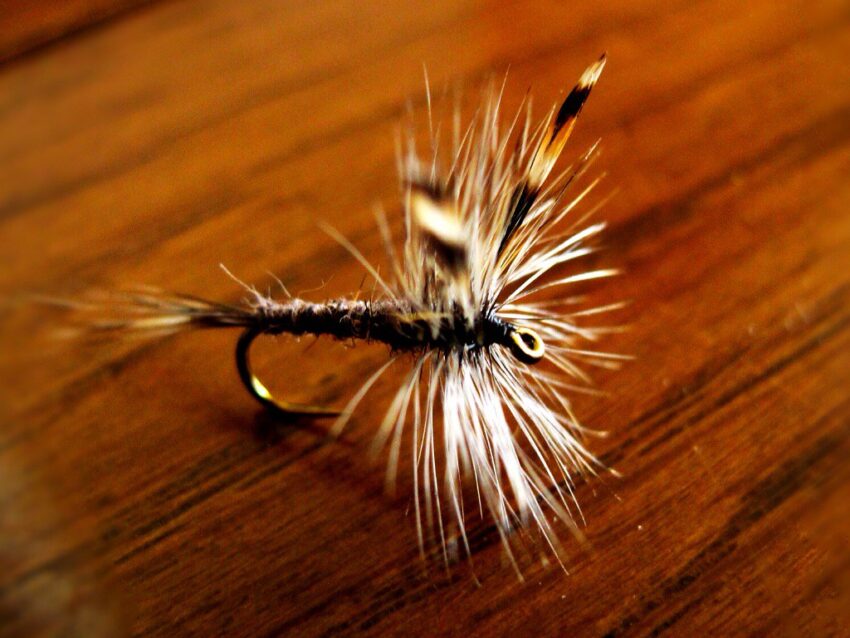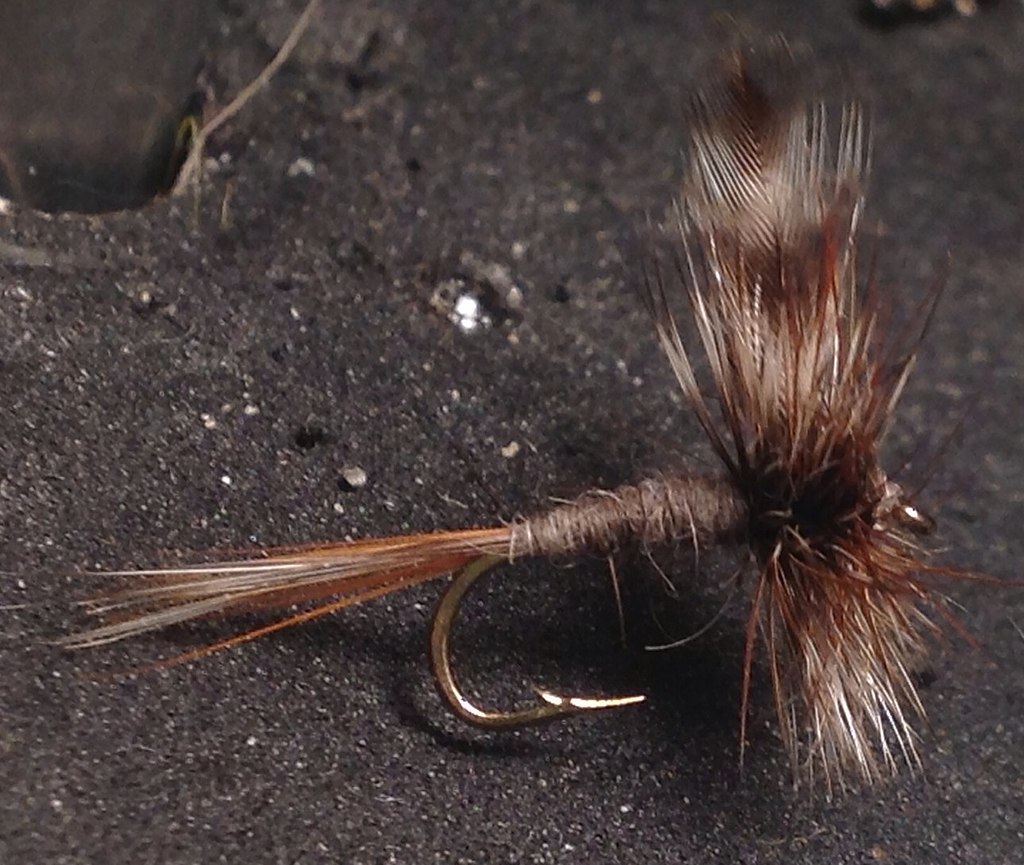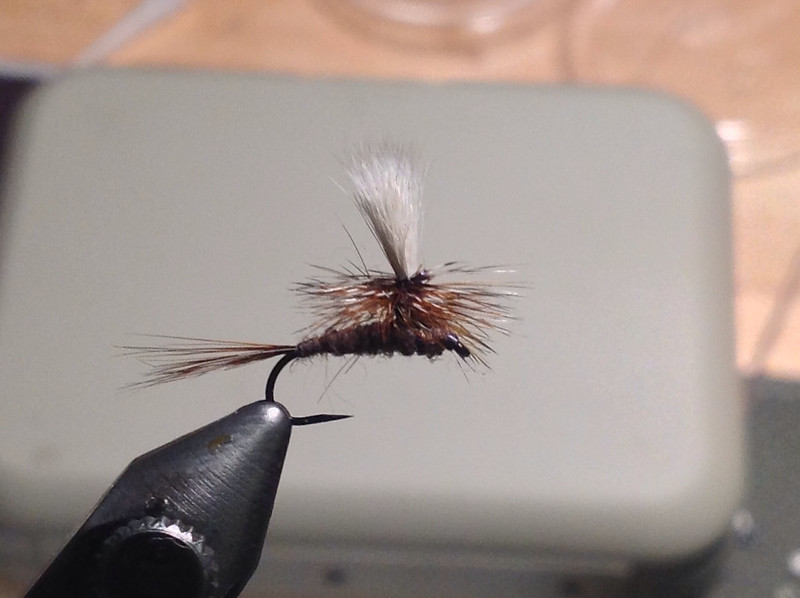
Adams Dry Fly – Recipes, Styles & Tying
For 100 years, it has been a fly that imitates nothing yet imitates everything.
The original Adams Dry Fly recipe was tied in the collared hackle, split-wing style. Today there are many different materials used and several tying style variations. Many will say, if they were limited to one dry fly, it would be the Parachute Adams. The Adams has, arguably, caught more trout than any other single dry fly pattern. What makes the Adams Parachute recipe below so effective?
- Generally “good enough” – though the Parachute Adams doesn’t imitate a specific species, it can resemble several on the water. These include Blue Wing Olives (BWO), Hedricksons, Caddis, March Brown, Green Drake and the list goes on. In a pinch, you can trim the hackle to make a spinner or keep trimming to make a nyphm.
- Great Search Pattern – we have all been there, staring in your fly box, nothing specific is rising, you don’t want to dredge nymphs, the water should hold trout and you need some place to start. This Parachute Adams Recipe will certainly produce a great searching pattern fly to test those waters.
- Everything Seems to Love it – Not just limited to trout, I have intentionally fished this pattern for sunfish, rising carp and have even caught bullfrogs on it! While sun fishing, I have had a bass or two take this fly.

Adams Dry Fly – Brief History
According to Wikipedia, “In 1922, Leonard Halladay, a Michigan fly tyer conceived the Adams as a general mayfly imitation. It was first fished by an Ohio attorney and friend of Halladay, Charles F. Adams on the Boardman River near Traverse City, Michigan. Charles Adams reported his success with the fly to Halladay who named the fly after his friend.” So, this fly could very well be named the Halliday, had ol’ Leonard not been so gracious to his friend, Charles Adams.
Original Adams Dry Fly Recipe
Since this pattern has been around for 100 years, and since fly tyers can’t ever not “improve” on the original, there are many variations out there to choose from. The original Adams Dry Fly Recipe:
- Hook: #14 Dry Fly Hook
- Thread: Dark Grey to Black
- Tail: Golden Pheasant Neck Feathers (which is a really cool looking bird)
- Body: Grey Wool
- Wing: Barred Plymouth Rock Rooster Feathers
- Hackle: One each, Barred Plymouth Rock and Rhode Island Red Rooster Feathers

Modern Material Substitutions
Given years of use and access to more varied options, the following material changes have been generally adopted to make the Adams Dry Fly recipe as it is tied and sold today:
- Hook: #10-#22
- Tail: Brown and Grizzly genetic hackle fibers
- Body: Muskrat, possum, squirrel or synthetic dubbing
There are no rules here and many folks change one or more materials to suit fishing conditions, available materials or whatever mood they are in at the vise.
Adams Dry Fly Styles – Collar, Parachute and Irresistible
The original, collar version, is still very effective and you can find plenty at your local fly shop. I am sharing one of my favorite tyers, Barry Ord Clarke, to demonstrate how to tie (his version) of the Adams Dry Fly in collar, parachute and irresistible versions. Let’s start with original Adams Dry Fly.
The Parachute Adams recipe simply subs out a post of hair, CDC or synthetic material for the wings and the hackles are wrapped around the base of the post horizontal to the hook shank instead of the front of the fly at a 90-degree angle to the hook shank. Barry again to demonstrate.
The irresistible version subs the dubbed body material for spun and closely trimmed elk or deer hair to form a tapered body. My man Barry to show you how it is done.
Comment below if you have a favorite Adams Dry Fly recipe to share. Contact me any time.
19 thoughts on “Adams Dry Fly – Recipes, Styles & Tying”
mj0o9m
Выбор аксессуаров для дизайнерской мебели премиум-класса.
Мебель премиум-класса [url=https://byfurniture.by]https://byfurniture.by[/url] .
Популярные мастерские по изготовлению серебряных колец в Саратове, где можно заказать неповторимые украшения.
Сколько стоит серебряное кольцо [url=http://xn--b1acnbnotaei0k.xn--p1ai/]http://xn--b1acnbnotaei0k.xn--p1ai/[/url] .
Надежный поставщик швейной фурнитуры в Москве для вашего бизнеса, продукция высочайшего качества.
Швейная фурнитура оптом [url=https://www.sewingsupplies.ru/]https://www.sewingsupplies.ru/[/url] .
Looking for a real date without endless swipes? I found a site that shows local girls who actually reply – https://d.webtune.space/
HeTith
Экспресс займ без фото паспорта на карту, средства моментально поступят прямо сейчас.
Займы без фото паспорта и снилса [url=https://niasam.ru/vklady__kredity__kreditnye_karty/zajm-bez-foto-pasporta-udobstvo-i-vazhnye-momenty-248466.html/]https://niasam.ru/vklady__kredity__kreditnye_karty/zajm-bez-foto-pasporta-udobstvo-i-vazhnye-momenty-248466.html/[/url] .
Cheers! A good amount of forum posts!
gcash online casino philippines https://combatcasino.info/tennis-betting/ gta online casino car today
Присоединяйтесь к букмекерской конторе с фрибетом, играйте без риска.
Букмекерские конторы с фрибетом без депозита [url=https://marina-sk.ru/]Букмекерские конторы с фрибетом без депозита[/url] .
Финансовая помощь в любое время, обратитесь к нам.
Все займы онлайн [url=http://www.lombardizumrud.ru/zajmy-onlajn-na-kartu-vzyat-mikrozajm-na-kartu-onlajn]http://www.lombardizumrud.ru/zajmy-onlajn-na-kartu-vzyat-mikrozajm-na-kartu-onlajn[/url] .
Great post. I am facing a couple of these problems.
RbtOV rva sOWzHkNZ FxSPlVeD AABXj
righqo
F*ckin’ awesome things here. I’m very glad to see your article. Thanks a lot and i’m looking forward to contact you. Will you kindly drop me a e-mail?
Wow! This can be one particular of the most beneficial blogs We have ever arrive across on this subject. Basically Excellent. I’m also an expert in this topic therefore I can understand your hard work.
fyqkztlqllifenjzzdjxuqxgrhzzhi
6lv0kc
Very interesting info !Perfect just what I was searching for!
Q: ✅ What is the airline code for JetX Airlines? Alternative Airlines made what would have been an otherwise difficult situation much easier to manage. Thank you, Alternative Airlines. A: Choose Telex if: You prioritize a proven track record, absolute battery-free simplicity (Airman 8 ANR), slightly lower cost, or if it’s standard familiar at your airline. Choose David Clark JET-X if: You prioritize maximum comfort (lighter clamp, better pads, cooling head pad), potentially better ANR performance, legendary build quality and customer support, and are okay with battery management (or have panel power). Many pilots report the Jet-X is significantly more comfortable for long wear. Both are top-tier tools; personal preference and priorities often decide. Q: ✅ What is the airline code for JetX Airlines?
https://djeridfm.com/review-football-x-by-smartsoft-the-ultimate-online-casino-game-for-indian-players/
When you search for the JetX download on your store, it may be challenging to find it. This is because there may be other crash apps with a similar name. All you need to do is go through the results and download the official Jet X application. JetX offers players an exciting opportunity to bet on the maximum height of the aircraft before it explodes, with higher risks that could potentially lead to higher payouts. Players use their skills and knowledge of the game to maximize their rewards while enjoying the excitement of online gaming while competing with others. Playing in JetX demo mode will help you better understand the game and learn about its subtleties. By practicing more and more, you will be able to master each round of the game without risking real money. Therefore, it is recommended that every beginner first spend some time on the demo version.
I have fun with, result in I found just what I used to be having a look for. You’ve ended my 4 day long hunt! God Bless you man. Have a great day. Bye